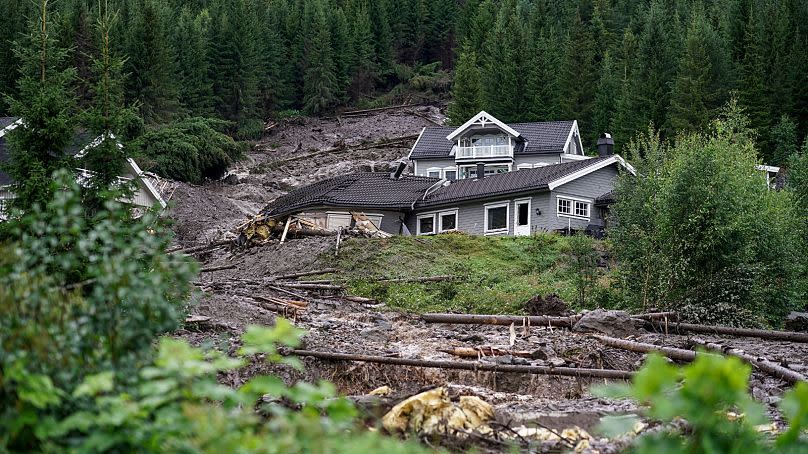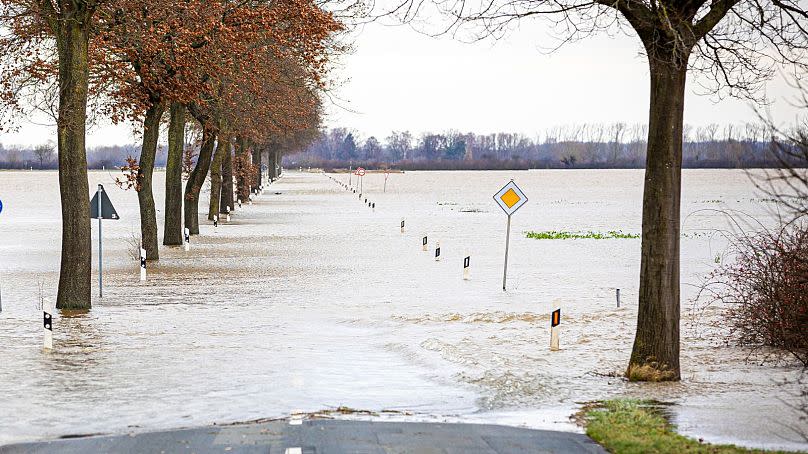Italy, Slovenia, Greece: Which European countries are most impacted by flooding as climate heats up?

One third of rivers across Europe breached the ‘high’ flood threshold last year, climate scientists have calculated, while 16 per cent swept past the ‘severe’ mark.
From Italy to Slovenia and Greece, swollen rivers took a deadly toll throughout 2023. The year ended with major river basins such as the Rhine and Danube at record or near-record levels.
This hydrological volatility is one big impact of the climate crisis on Europe, captured in extensive detail in the new State of the Climate report from the EU’s climate agency Copernicus and the World Meteorological Organisation (WMO).
“In 2023, Europe witnessed the largest wildfire ever recorded, one of the wettest years, severe marine heatwaves and widespread devastating flooding,” says Carlo Buontempo, director of the Copernicus Climate Change Service (C3S).

Our blue continent saw around seven per cent more precipitation than average, filling rivers to dangerous levels in some areas.
Floods claimed 44 lives in Europe last year - the same number who perished in wildfires - while storms caused 63 climate-related deaths.
Around 1.6 million people were affected by floods, which also caused the bulk of economic losses (81 per cent), according to early estimates from the International Disaster Database.
Climate change is creating a ‘cocktail’ of health hazards for 2.4 billion workers
Solar balconies are booming in Germany. Here’s what you need to know about the popular home tech
Five major European river flooding episodes in 2023
In 2023, 16 per cent of Europe’s river network saw river flows surpass the ‘severe’ flood threshold, defined by a 20-year ‘return period’. This means the flood event had a five per cent chance of occurring in a given year, compared to a five-year return period for the ‘high’ flood threshold category.
Storms made stronger by climate change were behind many of Europe’s worst flooding incidents, which Copernicus’s report provides an incisive retrospective on.
5. Storm Minerva strikes Italy, May 2023

The first serious trouble started in May, when heavy rainfall led to flooding in the Emilia-Romagna and Marche regions of Italy. Storm Minerva arrived on 16 May, bringing a deluge of rain to already saturated ground, after a first flood peaked on 2 May.
Flooding on the Reno, a major river that starts in the Apennines and flows northwestwards to Bologna, reached well beyond the ‘severe’ flooding bar.
In total, 23 rivers burst their banks, with some in the area reaching record-high levels. A large number of landslides ensued, and floods covered an area of 540 square kilometres.
Around 36,000 people were displaced from their homes and, as of 20 May 2023, there were 15 reported fatalities.
Italy’s Civil Protection Minister Nello Musumeci said at the time that the new normal of extreme weather events in the Mediterranean requires Italians to adapt and the country to rethink its flood protections nationwide.
“We can’t just pretend that nothing is happening,” he said. “Everything must change: the programming in hydraulic infrastructures must change, the engineering approach must change.”
4. Record-breaking rainfall lashes Slovenia, August 2023

Slovenia was impacted by heavy and persistent rainfall in early August, causing flooding which affected two-thirds of the country. A marine heatwave in the Mediterranean Sea at the start of August was partly to blame for the extreme rainfall.
Several locations recorded the largest rainfall amount in a record going back to 1950. Much of Slovenia’s river network was affected, with extensive flooding reported in the Drava, Savinja, Kamniška, Bistrica, Sora, Sava, Mura and Ljubljanica river basins.
River flow in the Sava peaked beyond the ‘severe’ flooding threshold. Around 1.5 million people were affected, with 8,000 people evacuated and six fatalities.
With total losses estimated at €4.7 billion, this is considered to be the most costly disaster in Slovenia’s history.
To stave off a repeat catastrophe, the government has embarked on a major flash flood adaptation effort: building up weirs, widening riverbanks and raising embankments among other works.
3. Storm Hans hits Norway and Sweden especially hard, August 2023

From 6 to 12 August, heavy rainfall, thunderstorms and strong winds brought by Storm Hans (named Storm Sylvia in Finland) battered much of northern Europe, including Norway, Sweden, Denmark, Finland, Estonia, Latvia and Lithuania.
There was flooding in Norway and Sweden, while other countries were more impacted by wind and hail.
This rainfall led to the highest August monthly-averaged river flows on record for the River Glomma in Norway, crossing the severe threshold. The Braskereidfoss hydroelectric power plant on the Glomma partially collapsed, causing further flooding downstream. More than 5,000 people were displaced in the flood.
In Sweden, river flows reached the 50-year return period. The storm uprooted one million m3 of trees, while a train derailment in the east of the country led to several injuries.
2. Storm Daniel causes devastation in the Mediterranean, September 2023

Greece, Bulgaria and Türkiye were impacted by record-breaking extreme rainfall and flooding when Storm Daniel made landfall in early September.
From 4 to 6 September, some locations in Greece received an average year’s worth of rain in one day. Approximately 700 square kilometres of land was flooded, according to satellite data, with the river flow in the Pineios peaking at far beyond the ‘severe’ flooding level.
Storm Daniel is likely to be the most intense storm, in rainfall terms, that Greece has experienced since records began in 1930. Experts believe it to be between a 1-in-80 and 1-in-250 year event, depending on the location.
17 people lost their lives in Greece and around 5,000 were displaced, with large swathes of agricultural land subsumed. Eight lives were also lost in Türkiye and four in Bulgaria.
But by the time Storm Daniel had travelled westward over the Mediterranean Sea - intensifying into a medicane - it hit with far more lethal force in Libya. At least 4,700 people lost their lives when the extreme rainfall and flash flooding caused dam bursts that flooded the city of Derna.
8,000 people were still missing as of mid-December 2023.
1. A series of five storms strikes in December 2023

The final ‘major river flooding episode’ that the report details was in fact a series of storms that struck in December. October to December brought more rain than normal to northwestern and central Europe, making lands saturated and vulnerable to flooding after five storms.
These were: Storms Elin (Vanja) and Fergus (Walter) in Ireland and the UK; Storm Pia (Zoltan) in the UK, southern Scandinavia, the Netherlands, Belgium and northern Germany; Storm Gerrit (Bodo) over Ireland, the UK, Norway and France; and Storm Geraldine (Costa) impacting Ireland, the UK and France.
Averaged across the river network for December, river flow was the highest on record.
“In northern Europe, particularly in winter, we’re more likely to see more rainfall events because the atmosphere is warmer, it can hold more moisture,” explains C3S deputy director Samantha Burgess. “These events are highly likely to be more intense.”
Almost a quarter of the waterways experienced ‘exceptionally high’ flows, especially across northwestern and central Europe, including major rivers like the Rhine and Danube. The Loire experienced record high monthly river flows in November.
Germany suffered flooding in several states, promoting a state of emergency and evacuation orders in the worst affected areas. The River Weser was among those that crossed the 20-year return period, just after Christmas.
Storms and flooding in the UK led to major travel disruption, power outages and damage from flooding, fallen trees, landslides and a tornado.
Can higher river flows be harnessed for hydropower?
There were numerous other flooding events in 2023, mapped out by the scientists; from deadly floods in Latvia and Belarus in April, to storm-driven overflows in Spain in September.
On the flipside of the hydrological climate coin, parts of Europe also suffered through droughts. In Spain, the Ebro was at near-record low flow in May. Italy’s Po had below average river flows for the whole year, linked to severe snow cover deficit in the Italian Alps.
For Europe as a whole, river flow was generally around average during 2023. But above-average precipitation highlighted the potential for one silver lining: run-of-river hydropower.
The form of renewable electricity generation was better than average in most countries last year, excluding Spain, Norway and Romania.
The end of year storms in particular led run-of-river hydropower capacity to peak at almost 20 per cent above average. Increased storminess also raised wind power production potential.
On a final positive note from Copernicus and WMO, 2023 saw a record proportion of actual electricity generation by renewables in Europe, at 43 per cent, with 17 per cent from hydropower.


